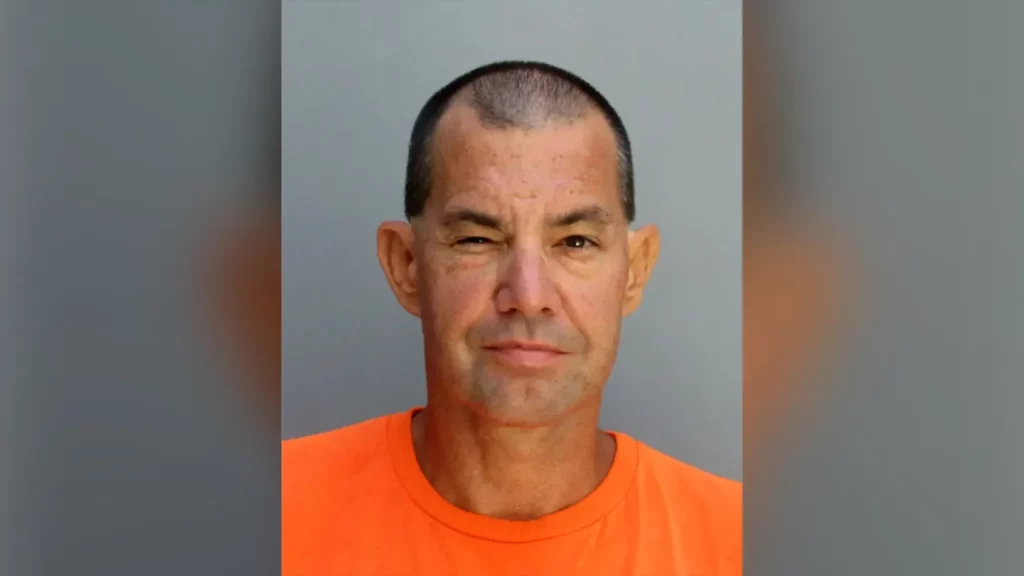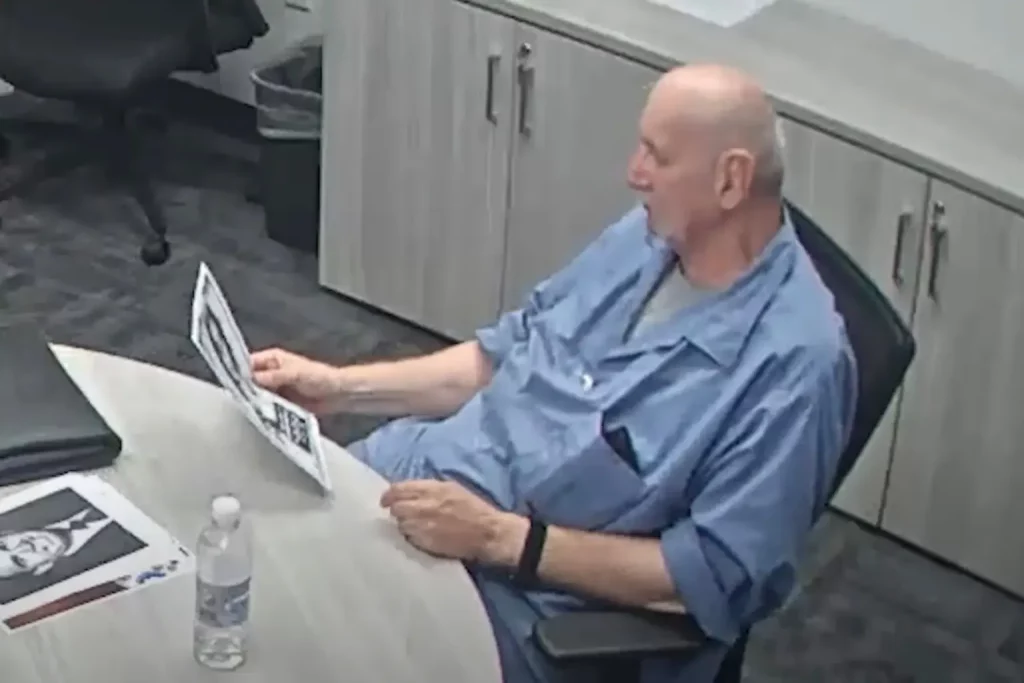
2025.3.20 Authorities may have lead on 35-year-old cold case murder of Okemos woman
LIVINGSTON COUNTY, Mich. – Livingston County Officials have confirmed with News 10 that they are working with Washtenaw County detectives on a lead that may solve a 35-year-old cold case.
Paige Renkoski of Okemos disappeared in May 1990 from her car on I-96 in Fowlerville.
Buster Robbins from Lapeer County is charged with the 1989 rape and murder of Beverly Wivell. That crime happened in Canton, just outside of Metro Detroit. Robbins is currently behind bars in Washtenaw County.
Just nine months before Renkoski disappeared, Wivell was sleeping in her car in Canton Township when she was abducted, assaulted, and murdered. Paige Renkoski stopped at a park in Canton before she disappeared. In both cases, the women’s cars were found running with their purses inside.
While Renkoski’s body has never been found, Wivell’s body was found in Washtenaw County.
Court documents show DNA from a rape kit collected in 1989 matches Robbins. Livingston County investigators say they are not ruling out Robbins as a suspect in Renkoski’s disappearance.
A judge ruled there is not enough evidence to send him to trial. He remains behind bars without bond while prosecutors appeal the decision.
2025.3.19 Arizona executes Aaron Gunches, first execution in a Dem-run state since 2017

Aaron Gunches, 53, had no final words and did not put up ‘any sort of resistance,’ Arizona official says
An Arizona man has been executed following his first-degree murder conviction in 2008.
Aaron Gunches, 53, was pronounced dead following the administration of lethal injection at 10:33 a.m. MST Wednesday at the Arizona State Prison Complex in Florence. Gunches pleaded guilty to fatally shooting Ted Price, his girlfriend’s ex-husband, in the desert outside the Phoenix suburb of Mesa in 2002.
“The process went according to plan, without any incident at all,” Arizona Department of Corrections, Rehabilitation and Reentry (ADCRR) Deputy Director John Barcello said in a post-execution media conference.
Barcello said Gunches did not put up “any sort of resistance.” When the death row inmate was asked if he had any last words, Barcello said Gunches shook his head, “no.”
Gunches’ final meal included a double western bacon cheeseburger with fries, a spicy gyro, a barbecue gyro, onion rings and baklava, Barcello said. He did not elect to have a spiritual advisor present with him during the execution process.
Gunches appealed his death sentencing in 2016, according to the ADCRR, but “the Supreme Court of the State of Arizona affirmed the conviction,” a statement said.
Gunches’ execution is the first in the state in more than two years. He is the first person executed in a state with a Democrat serving as governor since Virginia did so in 2017, when Terry McAuliffe was in charge, according to The Associated Press.
Gunches’ execution had originally been scheduled for April 2023, but was called off after Democratic Gov. Katie Hobbs ordered a review of the state’s death penalty procedures.
Late last year, Hobbs fired the retired judge she had appointed to conduct the review, and the state’s corrections department announced changes in the team that lethally injects death row prisoners.
“The Department is confident in both the quality and quantity of its pentobarbital supply,” ADCRR said in a statement.
“Appropriate testing occurred earlier this year, including a quantitative chemical analysis, which has been provided to Mr. Gunches, confirming a sufficient concentration of pentobarbital in the compounded solution. Additionally, sterility testing on the compounded pentobarbital was completed earlier this year, providing verification of the drug’s beyond use date. The results of this testing have also been provided to Mr. Gunches,” the statement said.
Gunches is the second of four death row prisoners in the United States executed this week. Louisiana executed a man on Tuesday and two more executions are scheduled in Florida and Oklahoma on Thursday.
2025.3.19 Investigators identify suspect wanted in connection to murder of father in Arcadia
Investigators from the Los Angeles County Sheriff’s Homicide Bureau have identified a suspect in connection to the murder of a father in Arcadia on March 11.
Zehao Lu, a 41-year-old, Chinese National, has been identified as the suspect, the sheriff’s department said. They are asking for the public’s help in locating him and believe he could have fled to China. Authorities warn he should be considered armed and dangerous.

Los Angeles County Sheriff’s Department
Last Tuesday, around 6:26 p.m. officers from the Arcadia Police Department responded to the 50 block of Woodland Avenue after receiving a call of an intruder at a home.
When officers arrived at the scene, they found a 61-year-old man suffering from a gunshot wound. First responders provided medical assistance before taking the man to a local hospital. He later died due to his injuries.
“The tragic homicide on Tuesday, March 11, resulted from a dispute between two individuals who were known to each other,” Arcadia Police Chief Roy Nakamura said. “While this targeted act of violence has deeply affected us all, we want to assure the community that Arcadia remains a safe place to live and work.”
Two other individuals were found at the scene, a 43-year-old woman and a 13-year-old boy.
Investigators said the boy had scratches on his head and neck and the woman was unharmed.
They believe Lu approached the woman and her son in the driveway of their home and forced them inside when a confrontation took place with the father. Police claim Lu shot the father before fleeing from the scene.
“Homicide investigators presented the case to the Los Angeles County District Attorney’s Office for filing consideration on Thursday, March 13, 2025,” the sheriff’s department said. “One count of murder, two counts of assault with a semi-automatic handgun, and one count of burglary with a person present to commit a felony was filed against Zehao Lu. A no bail warrant with an extradition order was issued.”

2025.3.19 Biloxi woman handed life sentence for first-degree murder, armed robbery following murder of best friend
BILOXI, Miss. – District Attorney W. Crosby Parker announced that 21-year-old Angel “Lexy” May Pierce, of Biloxi, pleaded guilty to first-degree murder and armed robbery following the 2022 murder of her best friend, 24-year-old Cody Smith.
On March 28, 2023, Harrison County investigators were contacted by Hinds County investigators about a missing person reported on December 16, 2022. Hinds County investigators identified the body as Smith, who they say was last seen in Harrison County.
After Harrison County investigators took over the case, investigators conducted interviews, leading them to a wooded area of Elmer Ladner Road in Pass Christian, where Harrison County Fire Rescue, Gulf Coast Search and Rescue and Long Beach CSI found Smith’s remains.
Upon further investigation, Pierce and then 24-year-old Jerry Cornelious Parkman were determined to be responsible for Smith’s death and arrested on first-degree murder charges. Parkman was already in jail due to an unrelated charge.
Prior to sentencing, Pierce addressed the court, saying, “I want to apologize to Cody Smith’s family and friends. Nobody should lose and bury their son. Cody was always there for me, and I betrayed his trust. I am haunted by Cody’s murder.”
Judge Steve Simpson pressed Pierce on the facts, asking, “What made you feel compelled to be a part of something like this?” Pierce replied, “I was angry about a lot of things and I was on drugs. It should have never happened.”
“Cody had an impact on more lives than I even realized, and some of them are here today,” Cherie Smith, Cody’s mother, said. “Cody was able to meet his niece when she was little, but she’ll never know him. I always wondered what he would look like as he grew older. We looked forward to meeting the girl that he felt was special enough to marry, and we couldn’t wait to hold and play with their baby, the grandbaby we’ll never have. Lexy took all that away from us. Nothing will make this better.”
Pierce was given a life sentence consecutive to 30 years to serve in prison. A co-defendant in Pierce’s case is set for trial in late April.
2025.3.18 91 years on, reminders of John Dillinger, Baby Face Nelson gang bank robbery remain
Current occupants of former Security National Bank and Trust in South Dakota reflect on notorious crime


SIOUX FALLS, S.D. — There’s a small concrete patch covering a hole in the Johnson, Janklow & Abdallah law office in downtown Sioux Falls, South Dakota, that’s not easily noticed.
Located on one of the towering columns gracing the building’s east wall, the patch is just a few inches off the ground, applied to cover a hole from a bullet fired from a Thompson machine gun. While not overly noticeable, it’s a big reminder of an intense Tuesday morning in 1934 when the John Dillinger and Baby Face Nelson gang arrived at what was then the Security National Bank and Trust.
They were there for the money inside, and they weren’t taking no for an answer.
“I grew up in Sioux Falls, so I remember as a kid and even in high school my dad and others had told me that that’s the building that John Dillinger and Baby Face Nelson robbed,” Scott Abdallah, managing partner at the law firm, told the Mitchell Republic in a recent interview. “As I understand it, they came in here, kind of got in here without a lot of fanfare, and they told everybody — get on the ground.”
It was the morning of March 6, 1934, another busy Tuesday in South Dakota’s most populous city. But the events that unfolded over the next several minutes remain a part of Sioux Falls history.
A violent robbery
The front page of The Daily Argus-Leader evening edition dated March 6, 1934, was awash with news about the robbery. By the time the sun set that evening, it was about all anyone in the community could talk about.
“Bandits Get $46,000; Hostages Freed, Trail Car; Keith Alive” and “Six Men Armed With Machine Guns Hold Police, Crowd At Bay As They Rob Security National” kicked off the coverage. The headlines cascaded down the front page from there: “Volleys Fired During Holdup,” “Girl Hostages Have Cold Ride With Robbers,” “Bandit Gloats As He Cuts Down Officer With Gun” and “Man Near Keith When He Is Shot Tells Of Brief Conversation” all tell an aspect of the morning’s events.
It all recounted the story of the gang headed by Dillinger, who was at the height of a yearlong crime spree from 1933 to 1934 where he and his gang robbed a number of banks and police stations across the country, and his legacy of becoming one of the most famous criminals in the world. Accounts from 1934 vary on who exactly was involved, but according to materials at Abdallah’s downtown office, those who pulled off the robbery that day included Nelson, Pretty Boy Floyd, Homer Van Meter, Harry Pierpont and Dillinger himself.
The action began that morning, when the criminals rolled up to the bank in a stolen brand-new 1934 Packard automobile. Contemporary reports suggest that bank employees were already suspicious of the vehicle when it arrived outside, but it became clear what was going on once they entered the bank. It also became clear to outlookers outside.
“Somebody hit the alarm, and that really ticked them off. Now the bells are going off at the bank, and so that can be heard outside,” Abdallah said. “There were hundreds of cars that then gathered because people then understood that there was probably a bank robbery going on.”
As some of the crew entered the bank and others remained outside in the vehicle, a crowd gathered, curious about what was going on. Among those who had arrived on the scene to investigate was Hale Keith, a motorcycle police patrolman.
One of the robbers, alleged to have been Nelson, spotted Keith through the northside window that looked out onto the street. He took aim and sprayed bullets through the window, shattering it and striking Keith several times, according to the report from the Daily Argus-Leader. The paper referred to the machine gun as a “typewriter” due to the noise it made and noted that the shooter gleefully shouted “I got one, I got one!” when he hit Keith.
Abdallah said his law firm began leasing the building about 15 years ago after having occupied another downtown building, and since then the interior has undergone an intensive renovation, but many elements still provide a connection to the robbery. A sunlit conference room now occupies the space where Nelson raked Keith with gunfire through the window.
Keith reportedly survived his brush with death, Abdallah said.
“The police started to converge on the building, and there’s a cop who ran down Ninth Street, and he ran right in front of our main conference room,” Abdallah said. “And Nelson, the story goes, was standing on a transaction table with a machine gun, and he saw the cop and just shot through the window. And somehow the cop lived.”
Making an escape
If bank employees and onlookers weren’t concerned before, the violent nature of the robbery and noise from machine gun fire certainly inspired panic. And the robbers took advantage of the chaos to grab as much loot as they could.
They demanded cash and got it — approximately $46,000 from accounts of the time, which translates to more than $1.1 million in 2025 currency — although the take was far less than the bandits had hoped for. A customer who was in the bank prior to the gangsters entering saw his safety deposit box plundered right in front of him by a member of the group. Another newspaper report from Alice Blegen, an employee of the bank who was later taken hostage, told the Daily Argus-Leader that the robbers used “descriptive language” with customers and employees as they held them at gunpoint, scooped up loose cash and called for the bank president to open the cash chests.
With the clock ticking and police alerted to the situation, the four gang members inside the building grabbed five employees — Mildred Bostwick, Emma Knabach, Leo Olson, Mary Lucas and Blegen — and forced them outside to the waiting Packard. There they were forced to stand on the vehicle’s running boards to act as human shields against potential police fire.
Laying down more gunfire, they then began to make their escape, using every trick they could think of to keep the police off their trail. That included dropping nails on the road behind them, an example of which is in the collection of the Siouxland Heritage Museums.
“They had bank tellers and an executive on the running board of the car to protect themselves, and then they threw these roofing nails to pop the police tires,” Abdallah said.
They drove off in the direction of Minnesota Avenue, eventually releasing Olson near 41st Street and the remaining hostages once the car had reached the countryside. With it technically being a late winter day and having no time to put on their topcoats, the hostages’ journey with the robbers was described as “a cold ride” by the Daily Argus-Leader.
Despite the intensity and violence, Blegen said the robbers were less hostile once they were away from town and the police, which jibed with Dilliger’s reputation as an otherwise personable individual and Robin Hood-type folk hero and celebrity among some of the public.
But it was still a scary, unforgettable experience, she said.
“It was a terrible experience. One which we will never forget. The bandits were nice enough after we reached the outskirts of town, but naturally we were frightened. The windows on the car were lowered and helping hands made it possible for us to remain on the running board,” Blegen told the Daily Argus-Leader. “I for one certainly hope I will never have to go through this again.”
From there the robbers evaded interstate police and airplane patrols as they made their way east through Minnesota. The stolen money, which was fully covered by insurance, was never recovered.
What was left behind was a trail of roofing nails, a seriously wounded police officer and frazzled public. Also left behind were several bullet pockmarks on the exterior of the building, which today are filled in with small concrete patches, including the one by the east door entrance of the building.
Later that year, Dillinger was gunned down by law enforcement outside a theater in Chicago after an acquaintance turned on him, bringing his reign of crime to an end. Federal officers confronted Dillinger after he exited a movie theater.
“So when they came out of the movie theater, the FBI had it surrounded and they saw him walk out and they yelled, ‘Hey, Johnny!’ And he turned and they just unloaded on him. They lit him up,” Abdallah said.
Coincidentally, the movie Dillinger saw that night was “Manhattan Melodrama,” a gangster drama starring Clark Gable.
Legacy
The event shocked the Sioux Falls community, which had been experiencing relative prosperity despite the ongoing national depression. Kevin Gansz, curator of education for Siouxland Heritage Museums, said the town, then with a population of just over 33,000, was seeing building permits on the rise, had a profitable agriculture and meat packing industry and its retail sector had done about $18 million in business that year, more than twice any other city in South Dakota.
No longer a bank, the structure at 101 S. Main Ave. still stands as a reminder of those days. It was built in 1915, though World War I delayed its completion until early 1917 because of the scarcity of materials, Gansz said. It was proclaimed the first steel skeletal office building in South Dakota, and over the years has been home to banks, doctors and other law offices. A historic marker now details the event on the outside of the building, and Abdallah said he occasionally sees visitors reading and talking about it from his office window.
The main two floors are now occupied by the law firm and have been extensively renovated, but there are plenty of artifacts from the robbery that remain, including the massive 28,000 pound main vault that the robbers raided, which was at one point was relocated to the bottom floor of the building and is now another conference room with a unique entrance.
“I bet there are 12 to 15 vaults in this building,” Abdallah said, pausing next to the wall where the main vault was once located. The wall now displays various pieces of memorabilia related to the building and robbery.
The office is a peaceful space now, quieter than even a bank lobby on a slow day. Walls are lined with legal reference books, and deep wood highlights and high ceilings make for a warm environment. Quiet chatter from adjacent offices drifts through the air. It makes it hard to believe that more than 90 years ago, a scene like that from a movie played out in real time there.
The nature of the robbery was so cinematic that it was even later featured in the 2009 historical biodrama film “Public Enemies,” in which Dillinger is portrayed by Johnny Depp, although the filmmakers portrayed the Sioux Falls robbery as an amalgamation of several robberies the gang committed in the Midwest around that time. An example of this is Dillinger being depicted has having been shot during the Sioux Falls robbery, which actually occurred later during a robbery in Mason City, Iowa.
Scenes from the film depicting the Sioux Falls robbery were filmed at stand-in locations in Oshkosh, Wisconsin.
Abdallah enjoys talking about the robbery, even if he prefers the comparatively serene environment his law office provides. The historic nature of the building will always be an interesting talking point, however, and he admits it is fun walking through the front door and the main vault entrance, knowing that some of the most famous mobsters from the 1930s had done the same.
“We tell people sometimes that we feel like a caretaker of a museum when we come to work. We’ve got our job to do, but we feel that we need to really treasure this space because it’s got a lot of history and a lot of meaning. So, yeah, it’s an honor to come to work here,” Abdallah said.

2025.3.18 An 82-year-old North Carolina man was arrested this week after new DNA evidence connected him to a 1979 murder case.
Kathryn Donohue, of Arlington, Virginia, was found dead at her home in Glenarden, Maryland, on March 3, 1979. Donohue was 31 at the time. Detectives investigated the case as a rape and murder, but a suspect was never identified, the Prince George’s County Police Department said in a statement on social media. The case remained open for decades.
In 2024, the Prince George Police Department’s Cold Case Unit reexamined the case and used a grant to submit forensic evidence for new analysis. Evidence from the crime scene was sent to Othram, a forensic laboratory that specializes in forensic genetic genealogy and genome sequencing. Scientists there were able to extract DNA from the evidence and develop a comprehensive genetic profile, Othram said in a news release.
That DNA profile was used to contact potential relatives and led investigators to a suspect who police identified as 82-year-old Rodger Zodas Brown.
Brown was arrested at his home in North Carolina last week, the Prince George’s County Chief of Police Malik Aziz said in a news conference on Tuesday. Brown is being held in North Carolina until he can be extradited, Aziz said, and has been charged with first degree murder, rape and related charges.
“This case serves as a reminder that we will never give up seeking the truth, no matter how much time has passed,” Aziz said.
Aziz said that police have not uncovered any connection between Brown and Donohue. Brown lived in Hyattsville, Maryland, at the time of Donohue’s murder, about seven miles from the neighborhood where Donohue lived.
The investigation remains open, Aziz said. Anyone with information about the case is asked to contact officials.
In a statement shared online, Donohue’s family thanked investigators for “their determination, their compassion, and their relentless pursuit of the truth which has finally given us a sense of closure that we never thought possible after all this time.”
2025.3.17 What to know about El Salvador’s mega-prison after Trump sent hundreds of immigrants there

SAN SALVADOR, El Salvador (AP) — The crown jewel of El Salvador’s aggressive anti-crime strategy — a mega-prison where visitation, recreation and education are not allowed — became the latest tool in U.S. President Donald Trump’s crackdown on immigration on Sunday, when hundreds of immigrants facing deportation were transferred there.
The arrival of the immigrants, alleged by the U.S. to be members of the Venezuelan Tren de Aragua gang, took place under an agreement for which the Trump administration will pay the government of President Nayib Bukele $6 million for one year of services.
Bukele has made the Central American country’s stark, harsh prisons a trademark of his fight against crime. In 2023, he opened the Terrorism Confinement Center, or CECOT, where the immigrants were sent over the weekend even as a federal judge issued an order temporarily barring their deportations under an 18th century wartime declaration targeting Venezuelan gang members.
What is the CECOT?
Bukele ordered the mega-prison built as he began his campaign against El Salvador’s gangs in March 2022. It opened a year later in the town of Tecoluca, about 72 kilometers (45 miles) east of the capital.
The facility has eight sprawling pavilions and can hold up to 40,000 inmates. Each cell can fit 65 to 70 prisoners.
CECOT prisoners do not receive visits and are never allowed outdoors. The prison does not offer workshops or educational programs to prepare them to return to society after their sentences.
Occasionally, prisoners who have gained a level of trust from prison officials give motivational talks. Prisoners sit in rows in the corridor outside their cells for the talks or are led through exercise regimens under the supervision of guards.
Bukele’s justice minister has said that those held at CECOT would never return to their communities.
The prison’s dining halls, break rooms, gym and board games are for guards.
How many prisoners does El Salvador hold?
The government doesn’t regularly update the figure, but the human rights organization Cristosal reported that in March 2024 El Salvador had 110,000 people behind bars, including those sentenced to prison and those still awaiting trial. That’s more than double the 36,000 inmates that the government reported in April 2021, a year before Bukele ramped up his fight against crime.
Cristosal and other advocates have accused authorities of human rights violations.
Cristosal reported last year that at least 261 people had died in El Salvador’s prisons during the gang crackdown. The group and others have cited cases of abuse, torture and lack of medical attention.
In slickly produced videos, the government has shown CECOT prisoners in boxer shorts marching into common areas and made to sit nearly atop each other. Cells lack enough bunks for everyone.
Why were immigrants sent to CECOT?
The migrants were deported after Trump’s declaration of the Alien Enemies Act of 1798, which has been used only three times in U.S. history.
The law requires a president to declare the U.S. is at war, giving him extraordinary powers to detain or remove foreigners who otherwise would have protections under immigration or criminal laws. Trump claimed the Tren de Aragua gang was invading the U.S. in invoking the wartime authority.
Tren de Aragua originated in an infamously lawless prison in Venezuela and accompanied an exodus of millions of Venezuelans, the overwhelming majority of whom were seeking better living conditions after their nation’s economy came undone last decade.
The Trump administration has not identified the migrants deported, provided any evidence they are in fact members of Tren de Aragua or that they committed any crimes in the U.S.
Video released by El Salvador’s government Sunday showed men exiting airplanes into an airport tarmac lined by officers in riot gear. The men, who had their hands and ankles shackled, struggled to walk as officers pushed their heads down to have them bend at the waist.
The video also showed the men being transported to CECOT in a large convoy of buses guarded by police and military vehicles and at least one helicopter. The men were shown kneeling on the ground as their heads were shaved before they changed into the prison’s all-white uniform – knee-length shorts, T-shirt, socks and rubber clogs – and placed in cells.
2025.3.16 Three men charged with kidnapping, robbing 14-year-old on Orange Line train
The men were wearing masks and made the teenage victim believe they had a gun, authorities said
Three men are facing kidnapping and robbery charges after preventing a 14-year-old from exiting an MBTA train, assaulting him and stealing his cell phone last week, authorities say.
Michael Cole, 23, of Boston, Derrick Eures, 25, of Dedham, and Nathan Moorewhite Jr., 19, of Dorchester, are all charged with kidnapping, armed and masked robbery and disorderly conduct on public conveyance, according to the Suffolk District Attorney’s Office.
“All forms of bullying and violence are intolerable, but this conduct toward a 14-year-old boy is particularly deplorable,” Suffolk District Attorney Kevin Hayden said in a statement.
The arrests stemmed from an incident on the afternoon of March 7, when MBTA Transit Police on patrol in the Forest Hills Station were approached by three youths who said their friend had been robbed while on the train.
The youths said they had boarded an Orange Line train at Roxbury Crossing Station heading toward Forest Hills Station when three unknown men, all wearing black face masks, began harassing them and threatening to beat them up. As the youths attempted to exit the train at the next stop, the man grabbed one of their friends and pulled him back onto the train, stealing his cellphone.
The 14-year-old victim exited the train at Stony Brook Station and was able to contact his friends and tell them that the men has stolen his cellphone. His friends told him to meet them at Forest Hills Station to report the incident to police, but he decided to go home.
Investigators later met with the victim, who told them that while on board the train, a man threatened to beat him up while making gestures as if he had a weapon. The victim said two other men assaulted him and took his phone, removing his phone case and handing him his CharlieCard, which was on the back of his case.
Video surveillance obtained by investigators showed the first man approach the youths on the train. As they tried to get off at Jackson Square Station, the two other man grabbed the victim by his backpack, turned him around and forcefully pulled him back onto the train car. They then slammed him against the opposite train car door.
After taking the victim’s cellphone, the first man is seen placing his hand into his sweatshirt, extending his hand while in the pocket and pressing his hand up against the victim’s abdomen. The victim is seen with both hands up in the video.
Shortly after 7 p.m. on that same day, transit police saw three men matching the descriptions seen on video and given by witnesses at Forest Hills Station. The men, later identified as Cole, Eures and Moorewhite, were all placed under arrest.
Investigators said they recovered the victim’s cell phone from Moorewhite’s possession. Cole already had an outstanding warrant out of Boston Municipal Center.
All three men were arraigned Monday in Boston Municipal Court and ordered held without bail pending a dangerousness hearing Thursday. At the Thursday hearing, a judge found all three men dangerous and released them on GPS monitoring with home confinement. They were all ordered to stay away from MBTA public transportation while their cases are ongoing. They are scheduled to return to court on May 20 for probable cause hearings.
2025.3.15 Progress made in 2016 murder case investigation

2025.3.15 Family of 2016 cold case victim speaks after arrest
LAREDO, Tex. – A breakthrough was made in a decade-long case as a suspect was named in connection to the murder of Janette Escamilla Jaramillo.
Maria Rivera was only 16 years old when she lost her mother. Since then, she has not known who and why someone would kill her.
However, that all changed when Texas Rangers, the Webb County District Attorney and Laredo Police announced there was a break in the case.
42-year-old Sergio Mendez was indicted on Jaramillo’s murder. She was last seen walking by a business in San Bernardo on May 18, 2016, past midnight.
Maria Rivera and her siblings are now reliving that day, and they note that it has been a lot for them to handle.
Police say DNA evidence left at the crime scene and the utilization of technology not available in 2016 connected Mendez to the crime.
“I just felt happy; I felt happy that my mom is going to get justice; after 9 years, that’s crazy,” Maria Rivera said.
For her, the last few years have been difficult, especially reliving the last words she had with her mother.
“It’s been hard because who doesn’t need their mom in their life? I have to live with that. I fought with my mom. That was the last thing, and we were super close to my mom. It was hard,” she said.
A trial date is yet to be set. Jaramillo’s children, like Perla Rivera, want their mother to be remembered for who she was.
“She had a warm heart, was very nice, very understanding and had a lot of patience. She was a really good role model, and I follow that model for her,” Perla Rivera said.
Mendez is currently serving a 10-year prison sentence in Edinburg, Texas, for another crime.
Jaramillo’s family continues to remember and hope justice will be served.
Police, along with the DA’s Office, say they were able to make the breakthrough because of the Sexual Assault Kit Initiative (SAKI).
—
2025.3.14 Progress made in 2016 murder case investigation
LAREDO, Tex. – After nearly 10 years, there has been a break in the murder of Jannette Escamilla Jaramillo.
The mother of nine was found dead at 1508 Monterrey Ave., Seven Flags Park, on May 18, 2016.
According to Webb County District Attorney Isidro Alaniz, there were signs of attempted sexual assault and a struggle.
A grand jury issued a true bill of indictment to 42-year-old Sergio Mendez as the suspect connected to Jaramillo’s murder. Currently, he is serving a 10-year sentence in prison in Edinburg, Texas, for a separate crime.
Authorities were able to link Mendez to the crime after examining DNA samples and utilizing updated technology.
“Jannette deserved justice,” said Laredo Police Department Chief Miguel Rodriguez during a press conference on Friday, March 14, announcing the latest developments in the case.
2025.3.14 2 Chinese nationals charged in massive gift card fraud scheme in Metro Detroit
Two Chinese nationals were arrested and charged for a gift card scheme involving thousands of cards..
The Michigan attorney general announced that Guangji Zhang, 46, of Irvine, California, and Huachao Sun, 35, of Los Angeles were both arraigned on March 7, accused in a large scale fraud enterprise.
Zhang and Sun were arrested at a Dearborn hotel on March 5. They have been charged each with one count of Conducting a Criminal Enterprise, a 20-year felony, and two counts of Possession of a Fraudulent or Altered Transaction Device, AG Dana Nessel’s office.
A package determined to be suspicious by the USPIS agent was found to contain more than 1,500 gift cards and was addressed to the two defendants at the Dearborn hotel.
Investigators say the scheme involved the theft of empty, unsold gift cards from retail stores. The cards were then tampered with to reveal their redemption numbers, recorded by the scammers.
They were then concealed again with an adhesive to appear as though they have not been tampered with, Nessel’s office claims.
It is alleged that the scammers then returned the altered gift cards to their retail point of sale and used computer programs to monitor when any card is activated with a balance of funds.
As soon as a shopper placed a balance on the card, the scammer was then able to transfer the balance into another digital account. The gift card, when given as a gift and redeemed, would already be depleted.
Nessel released a video Friday alerting Michiganders to the gift card scam, detailing how the scam is believed to operate, and offering tips to avoid becoming a victim.
This investigation was initiated by a special agent of the United States Postal Inspection Service, a federal partner of the Attorney General’s FORCE Team.
The Focused Organized Retail Crime Enforcement team with the Michigan State Police Fraud East team, surveilled the package recipients who, allegedly, visited Meijer locations in White Lake, Waterford, Auburn Hils, Southgate, Allen Park, and Taylor over two days placing altered gift cards back among store stock.
On March 5th, the men were arrested at their hotel and search warrants were executed on their vehicle and hotel room. In all, the Attorney General alleges, the men possessed more than 3,000 gift cards.
“Sophisticated fraud schemes undermine consumer trust and can cause significant financial harm, and I am proud of my FORCE Team for their efforts to shut down these operations and hold bad actors accountable,” Nessel said. “They will continue to pursue and prosecute those who engage in scams targeting Michigan residents and businesses. I urge everyone to stay alert and be cautious when buying gift cards. Taking a few extra moments to check for tampering can save you from becoming a victim.”
Each defendant will next appear before the 51st District Court on March 18 at 2:30 p.m. for a probable cause conference.
The FORCE Team has worked with retailers and crime. FORCE is an acronym that stands for Focused Organized Retail Crime Enforcement. Recent corporate partners on investigations have included Sam’s Club/Walmart, Meijer, Target, Home Depot, TJ Maxx, Rite-Aid, Lululemon, Ulta Beauty, Amazon, and Lowe’s.

2025.3.13 Woman arrested after discussion about religion turns violent in Miami-Dade, records show
Deputy arrests woman for domestic violence, reports mother suffered ‘deep tissue’ injury
MIAMI – A 30-year-old woman appeared in court on Thursday morning after deputies reported that an argument about religion turned violent in Miami-Dade County.
Deputies arrested Ingrid Alcover, who uses a wheelchair, for domestic violence at about 5:20 p.m., on Wednesday, near the Tamiami area.
According to a deputy’s arrest report, the argument between Alcover and her 76-year-old mother got heated as they discussed “faith.”
According to the deputy’s report, Alcover “grabbed” her mother’s right arm “and bit her causing a deep tissue penetration that will leave a permanent disfigurement.”
Records show corrections booked Alcover, who was born in Michigan, shortly before 9:20 p.m., on Wednesday, at the Turner Guilford Knight Correctional Center.
After spending the night in jail, Alcover appeared before Miami-Dade County Circuit Judge Mindy Glazer, who released her from custody without posting bail after the victim described the injury as “a mark” and “bruise” even though her arm was bandaged.
“Only friendly non-violent contact is allowed,” Glazer told Alcover in court about her stay-away order.
Miami-Dade County Circuit Judge Richard Hersch is set to preside over the case. Before Wednesday, Alcover didn’t have an arrest record in Miami-Dade.
2025.3.12 1975 murder of Maryland woman solved with help of old cassette tape and photo of victim

Howard County Police Department

Howard County Police Department
The 1975 murder of a Maryland woman was finally solved with the help of an old cassette tape and a picture of the victim, authorities announced Tuesday.
The cold case of Roseann Sturtz, who was strangled after meeting her assailant at a bar on Aug. 24, 1975, was a mystery for decades until Howard County police revived the probe late last year and uncovered evidence that a convicted killer already in prison had committed the crime.
Detectives discovered a 1981 audio tape in which Charles William Davis Jr., then incarcerated at Jessup Correctional Institute, was asked about the murder in exchange for not facing charges in the case.
At the time, Davis could not identify Sturtz, who lived in Baltimore and went by Ann, as one of his victims after he was shown a photo taken of her several years before her murder, police said.
But Howard County police Cpl. Wade Zufall then brought Davis from the same jail to police headquarters last year to interview him again 44 years later.
He showed Davis a later photo of Sturtz — a headshot taken a month before she was killed.
This time, he identified her as one of his victims and admitted to the slaying.
Footage released from the interview shows Sturtz nodding his head as he took a look at the photo.
“In November 2024, we were grateful to have all the case details, learned Roseann’s actual date of death and receive the closure we have been praying for all these years — finally put to rest the answers we never had,” Sturtz’s family said in a statement through the police department.
Davis told police that after meeting Sturtz at a bar, the pair got into an argument before the murder, Zufall said.
Davis landed on authorities’ radar in 1981 after police studied his confirmed victims and compared them to Sturtz, Zufall said during a press conference.
Davis can’t be charged with the murder, but is already in prison for life for other killings.
“His main reason why he wanted to talk to me … was he wanted to give closure to the family,” Zufall said.
2025.3.12 Woman charged, 4 rescued from human trafficking ring at massage parlors in Oakland, Wayne counties
Woman charged, 4 rescued from human trafficking ring at massage parlors in Oakland, Wayne counties
Zixuan Wan, 44, of Livonia, charged


OAKLAND COUNTY, Mich. – A Livonia woman has been charged in connection to a human trafficking investigation involving illegal activity at massage parlors in Oakland and Wayne counties, officials announced.
Zixuan Wan, 44, was charged with two counts of human trafficking and keeping a house of prostitution after a four-month investigation into the massage parlors the woman operated.
Four women from China who don’t speak English were rescued from three separate massage parlors operated by Wan, Oakland County Prosecutor Karen McDonald said during a press conference on Wednesday, March 12, 2025.
Investigators learned that the women were allegedly being forced to live in the massage parlors in Commerce Township, Farmington Hills and Westland, working from 9 a.m. to 10 p.m. seven days a week. They provided massages to a mostly male clientele.
The prosecutor said they didn’t have access to transportation, medical care or friends and family.
In addition, the women allegedly received no or minimal payment for their work.
While there is evidence that shows the victims were forced to participate in sex work, the case also highlights the problem of labor trafficking, according to the prosecutor.
“Trafficking, whether it be for labor, and in this case there’s elements of both, there was a promise for work once they came to this country, sex trafficking, it all depends on one critical thing— a vulnerable victim.”
The charges come after the Oakland County Prosecutor’s Office brought together law enforcement officials and mental health professionals for a human trafficking training course last year.
In November 2024, just days after receiving that training, Farmington Hills police began investigating Wan.
While investigating Wan’s massage parlor in Farmington Hills, they learned that the Westland Police Department Special Investigations Unit and the Oakland County Sheriff’s Office Special Investigations Unit were also investigating other massage businesses that Wan operated in their jurisdictions.
A coordinated investigation ensued, and on March 5, authorities conducted search warrants at the woman’s massage businesses in Farmington Hills, Commerce Township and Westland, her home in Livonia, and banks where authorities believed illegal funds were being deposited.
Investigators identified homes, vehicles and commercial real estate that appear to have been paid for through this criminal enterprise.
About $140,000 in cash was seized from a safety deposit box associated with the suspect during the investigation.
The women were rescued and taken to Common Ground and CARE House in Oakland County to receive victim services.
“Finally, I want to just say, to the customers of these illicit massage parlors, that a sexual massage may seem like a victimless crime or a consensual transactional act, but for trafficking victims, they do not have the ability to consent,” said McDonald. “It is not a victimless crime. Take responsibility for how your actions may enable trafficking and the abuse of vulnerable women.”
And if that’s not enough to prompt change, McDonald said that her office can and will prosecute customers who do business with sex traffickers.
Wan was arraigned on Thursday, March 6, 2025, and a not guilty plea was entered on her behalf.
She was given a $100,000 personal bond with the conditions that her passport must be surrendered and that she must wear a GPS tether if released.
Her preliminary examination conference is set for March 21.
“The successful outcome of this investigation is the result of the strong partnerships that the Farmington Hills Police Department maintains with agencies throughout Oakland County and beyond,” said Farmington Hills Police Chief John Piggott in a release. “I’m continually impressed with the men and women of the Farmington Hills Police Department who are constantly seeking out training opportunities and bringing the skills learned back to the Department. These skills directly lead to law enforcement intervention, rescuing these vulnerable women from further exploitation. Because of their excellent work and our collaboration with outside agencies, a dangerous human trafficker will be held accountable.”
The chief also asked residents and business owners to report unusual business activity to the authorities.
The investigation is ongoing, and additional charges are expected.

2025.3.11 Mother accused of killing newborn in Easley, no bond set
EASLEY, S.C. – A woman is behind bars, accused of killing her baby as she delivered the child on March 7.
According to the Easley Police Department, An T. Ngo showed up to her bond hearing straight from the hospital.
The judge at Ngo’s hearing could not set bond, due to the charge of homicide by child abuse carrying a life sentence.
Easley Police Chief Brandon Liner said officers were called to Nations Way near Powdersville Road on Friday night.
“The reason they responded was because it was an EMS call for service,” Chief Liner said. “They get on scene and realize very quickly. This is something much more.”
According to warrants released by the police department, Ngo is accused of repeatedly stabbing her baby with a long metal letter opener while and after giving birth to him, cutting the umbilical cord, putting him in a black trash bag and moving him to another room in the apartment.
Reports also said that Ngo confirmed her actions to police as she was read her rights.
“It was very apparent that Ms. Ngo is the one who tragically murdered this child and it is at that time we went ahead and applied for a warrant for a homicide by child abuse,” Chief Liner explained.
Chief Liner said this case is unlike anything he has experienced in 25 years.
“I’ve been doing this for two-and-a-half decades and I’ve never seen anything this gruesome, anything this bad,” said Liner.
Liner said the investigation into the infant’s death is still in its early stages, but that his team will make an effort to hold those responsible accountable.
“We are fully committed to uncovering the truth of this incident, holding the responsible accountable and ensuring justice is found for this child.”
Officials said that a bond for Ngo should be set by the circuit court judge in the next 30 to 45 days.
2025.3.11 Missing American college student seen on resort surveillance in Dominican Republic
Sudiksha Konanki, a University of Pittsburgh student from Virginia, disappeared in Punta Cana, Dominican Republic
PUNTA CANA, Dominican Republic – A 20-year-old college student was last captured on surveillance footage gallivanting with friends during their spring break trip at a resort in the Dominican Republic before she mysteriously vanished.
Sudiksha Konanki, a junior pre-med student at the University of Pittsburgh, was last seen on surveillance camera with five other people entering the beach at the Riu República Hotel in Punta Cana after 4:15 a.m. Thursday, the Dominican National Police said in a statement.
Surveillance video, obtained by Noticias SIN, captured the group striding towards the beach at the five-star resort.
The footage is the last time authorities tracked Konanki before the Virginia resident disappeared.
Konanki’s disappearance has sparked widespread speculation about the events leading up to it, prompting law enforcement in both the Dominican Republic and the U.S. to investigate.
Konanki was seen for the last time at 4:15 a.m. walking on the beach outside the RIU Republica Resort on March 6, according to the Dominican National Police.
The footage captured Konanki accompanied by two men and three women. The 20-year-old was seen clinging to a blonde man, whom authorities identified as a “male friend.”
Authorities said that the male friend who was with Konanki around the time of her disappearance is under investigation.
It is unclear who the “young man” is, but police said he was in the water at the same beach, and they are questioning him in an attempt to corroborate his version of events, according to a translation of a Spanish-language statement.
Authorities have not named any suspects amid their ongoing investigation. In a release on Tuesday, the Dominican National Police said that they are “re-interviewing targeted individuals who were in the victim’s proximity at the time of her disappearance.”
“This includes hotel employees where Konanki and her companions were staying, with the goal of gathering information to corroborate her movements, interactions, and any relevant details for the investigation,” they said.
When asked about a Monday report that Konanki may have drowned, a spokesperson for the Loudoun County Sheriff’s Office told Fox News Digital authorities “have heard this and have seen no evidence presented at this time.”
A joint investigation into Konanki’s disappearance is being conducted by the U.S. Embassy in the Dominican Republic, the Dominican National Police and the Dominican Prosecutors Office. The FBI is also assisting.
2025.3.11 Texas appeals court blocks scheduled execution of David Leonard Wood
EL PASO, Texas (EL PASO MATTERS) — Texas’ highest criminal court on Tuesday blocked Thursday’s scheduled execution of David Leonard Wood, the man sentenced to die for the 1987 deaths of six girls and young women whose bodies were buried in the Northeast El Paso desert.
The unsigned order was issued per curiam by the Texas Court of Criminal Appeals, meaning it was done in agreement with a majority of the nine judges. Judges Mary Lou Keel and Gina Parker disagreed with the decision. Judge Bert Richardson – who has handled Wood’s appeals at the trial court level since 2011 – didn’t participate in the decision.
The judges outlined the issues raised in the latest appeal, but didn’t list reasons for their ruling. “The stay will remain in place until further order of this Court,” the ruling said.
The order was issued less than 48 hours before Wood was to be executed by lethal injection at the state prison in Huntsville. It was the second time the Texas Court of Criminal Appeals had stepped in to block Wood’s execution days before he was to be put to death.
“I don’t know why they keep doing this. It’s like they’re playing a game,” said Marcia Fulton, a Northeast El Paso resident whose 15-year-old daughter, Desiree Wheatley, was among those killed in 1987.
Wood’s attorney, Gregory Wiercioch, couldn’t immediately be reached for comment.
Wood, now 67, was indicted on a capital murder charge in 1990, three years after nine girls and young women were reported missing in and around Northeast El Paso. From September 1987 through March 1988, the remains of six of the missing girls and young women were found in shallow graves in the Northeast desert, where Painted Dunes Golf Course is now located.
Wood was accused of killing the six women whose remains were found: Ivy Susana Williams, 23; Desiree Wheatley, 15; Karen Baker, 20; Angelica Frausto, 17; Dawn Marie Smith, 14; and Rosa Maria Casio, 24.
No sign of the other three missing women and girls – Marjorie Knox, 14; Melissa Alaniz, 13; and Cheryl Lynn Vasquez Dismukes, 19 – has ever been found. No one has been charged in their disappearances.
The discovery of multiple shallow graves in the Northeast desert sparked a wave of fear in El Paso. It was El Paso’s deadliest crime spree until 2019, when a gunman killed 23 people and wounded 22 others in a racist mass shooting at the Cielo Vista Walmart.
Wood’s trial was moved to Dallas in 1992 because of extensive pretrial publicity in El Paso. A jury found him guilty of capital murder in November that year, determining he killed Williams and at least one of the five other victims. The jury sentenced Wood to death four days after convicting him.
He always maintained his innocence, through the trial and decades of appeals.
Wood faced an execution date in 2009, but the Texas Court of Criminal Appeals stayed the execution a day before it was set to happen to allow Wood’s lawyers to pursue a claim that he had an intellectual disability that barred the death sentence.
But that appeals and a series of requests for DNA testing of evidence were turned down by the courts over the years. Wood’s defense lawyers were critical of the state for objecting to DNA testing, especially after one of three tested blood samples in 2010 excluded Wood as the source of the blood.
Prosecutors and the courts said the one blood sample would not have altered the jury’s decision in 1992, and further tests weren’t allowed.
Wood’s attorneys made multiple last-ditch appeals in state and federal courts in recent days to stop the execution.
He had an extensive history of sex crimes before being charged with the 1987 killings.
In 1976, when he was 19, Wood was sentenced to five years in prison for indecency with a child. He was paroled in 1978.
In 1980, when he was 23, Wood was sentenced to 20 years in prison for raping a 19-year-old woman and 13-year-old girl over an eight-day span. He was paroled just over six years later, in January 1987, and returned to Northeast El Paso.
Wood also was found guilty of the 1987 kidnapping and sexual assault of a woman who survived the attack. His lawyers said the victim initially identified another man but changed her story under police pressure. She testified against Wood in his capital murder trial.

发表回复